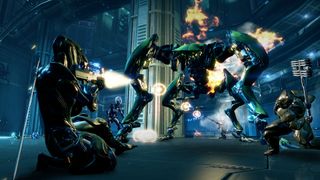
Digital Extremes' daunting co-op shooter doesn't go easy on new players, but we're here to help.
When you purchase through links on our site, we may earn an affiliate commission. Here’s how it works.

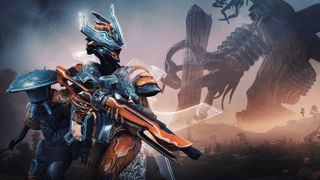
When Warframe first came out in 2013, it was a largely forgettable free-to-play shooter. But Digital Extremes has been quietly making it one of the best games on PC, so we figured it was time to see what all the fuss was about, and, yup, Warframe is excellent.
Warframe is one of the most complex and brilliant free-to-play games on PC. Though it started as a simple loot shooter set on randomly generated maps, developer Digital Extremes has slowly grown it into a sprawling pseudo-MMO with open world zones, public space stations to barter in, and a crafting and modding system so in-depth it can take hundreds of hours to fully understand. Warframe is a great but intimidating game—and new players are sure to be overwhelmed.
Part of that is due to how open-ended Warframe is. While a Star Chart helps guide you from one mission to the next, Warframe offers next to no guidance for what new players should try to achieve and, just as importantly, how they can achieve it. But that journey of self-discovery is half of the fun, so this guide won't be a checklist of items to mindlessly complete. Instead, I want to help you understand Warframe's myriad of complex systems and arm you with the tools so that when you inevitably become lost (and, trust me, it'll happen) you know where to turn.
Before we get too far, it's a good idea to complete the intro missions and glance through Digital Extremes' quick start guide to get a gist of the basics.
It's imperative that you understand what Warframe is and what it isn't. Digital Extremes' shooter is somewhat comparable to games like Destiny 2 and Borderlands but with a much greater emphasis on crafting and trying new playstyles. You play as a Tenno, a mystical space ninja in a far future version of our solar system where various post-human factions vie for control. To help restore balance to the solar system, you don fabled suits of armor called warframes and take them into battle. These warframes are like your character class, and each one has a set of four unique abilities to use in combat. Unlike typical RPG shooters, however, you can craft new warframes and swap between them in between missions so you're never confined to one playstyle.
While you won't see thousands of players on screen at once, Warframe shares a lot of DNA with MMOs. Simply put, this is a game that people frequently put thousands of hours into and it takes a long time to achieve anything noteworthy.
That said, Warframe also differs from MMOs in several key areas:
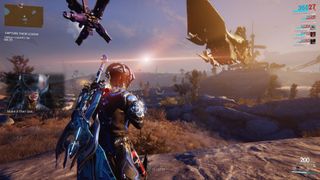
Finding a clan to join will take a bit of work, but the Warframe subreddit's weekly recruitment thread is the best place to start. Other places to look are the Warframe wiki clan recruitment board and the official Warframe forum clan listing.
Don't overthink the decision too much for now. Offer to join a large clan and explain to the recruiter that you're new and they'll help you get situated. Once you're in a clan, you'll have access to chatrooms in-game (and usually through third-party services like Discord) where you can ask questions of other players. Don't be shy, either. The Warframe community has a reputation for being one of the most helpful and patient in part because the game is so intimidating to newcomers. The other upside is that missions are much more fun with a coordinated group rather than alone or with strangers.
It's important to understand that learning everything is part of Warframe and is a slow grind that will take time. It's easy to get confused by all the terminals in your spaceship and all the little nuances and wrinkles involved with any one system. And when that happens, your best bet is to head out to the Star Chart and take on a new mission and have some fun killing shit for a while.
Completing the Star Chart is one of the few universal objectives every Warframe player should complete. Not only will doing so unlock access to powerful weapons and warframes, but it will also open up new quests, provide access to cool public space stations, and a lot more. It'll take roughly 50 or more hours to do it, but completing those missions are the key to doing anything fun in Warframe.
Along the way, as you come to grips with Warframe's systems, you can begin diverting more and more time to other pursuits. For new players, the most exciting of those is often building new weapons and warframes.
The first warframe I would recommend building is Rhino because his Iron Skin ability makes him nigh-indestructible early on. To craft Rhino, you need blueprints from the Fossa assassination mission on Venus—essentially that planet's final boss. Each time you beat The Jackal, you'll be rewarded with a random blueprint which builds one of three Rhino components: neuroptics, systems, or chassis. All three take 12 hours to build and must be completed before building Rhino itself. Once you've farmed The Jackal, gotten all three blueprints, and constructed the requisite components, you can then buy the Rhino blueprint from the market on your ship and begin the final build which will take 72 hours. Once you have Rhino completed, you can level him up while deciding what other warframes you'd like to add to your arsenal.
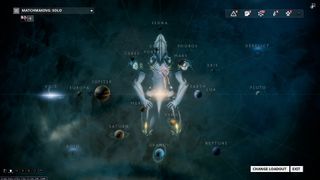
Meanwhile, experiment and build new weapons using blueprints purchased from the market or obtained as loot. Ranking up that gear will increase your Mastery Rank (explained below) and will eventually unlock access to the Hek shotgun at Mastery Rank 4. This is a great newbie-friendly weapon that packs such an immense punch it'll easily last you until the very end of the Star Chart. The Hek blueprint can simply be purchased from the market after you reach Mastery Rank 4.
At first, Warframe seems like a pretty simple game: You run through levels killing bad guys, completing objectives, and collecting resources. And then, after the tutorial missions are over, you'll be shown the modding and upgrading systems—an indecipherable mess of proper nouns and open-ended customization that feels impossible to grasp. It's a breaking moment for many new players. Don't worry, though, once you start to understand some basic principles it all becomes a lot more comprehensible.
One of the biggest differences in Warframe is that your level doesn't automatically make you powerful. Your warframe might be the max rank of 30 but enemies will still poke holes in you like a wet napkin. Unlike most RPGs, the level of your gear in Warframe is merely an indicator of its potential. In order to fulfill that potential you'll need to modify and customize that gear using mods. To understand why is to understand Warframe's myriad progression systems and how they overlap.
Mastery Rank is the closest thing you have to an overall character level. Each time you level up a piece of equipment like a weapon or warframe to rank 30 by using it in combat, you gain a small bit of Mastery Rank. At certain thresholds, you can undertake a quick trial to increase your Mastery Rank, unlocking the ability to wield more powerful weapons and gaining some secondary upgrades like one extra base mod capacity in all your gear (explained below).
Rank is the level of each piece of equipment and it maxes out at 30. It's a bit complex, but by simply equipping that gear and taking it on missions it'll slowly earn experience points (called affinity) and rank up. The only thing that ranking up a piece of gear does is increase its Mod Capacity—increasing the potential to fit more and more powerful mods to augment that gear's base stats.
Mods are found from all sorts of sources and provide a ton of different upgrades. These are essential because they are what makes any piece of gear powerful. More basic mods might simply increase a weapon's damage while others might add elemental damage or trigger special effects. Collecting and upgrading these mods (there's over 800 of them!) is what will actually make you powerful in Warframe.
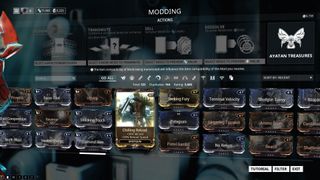
There's so much to learn about mods, but focus on one simple philosophy: Mods are best used to emphasize the inherent strengths of your gear. If you're playing a warframe like Valkyr, for example, you're far better off using the Steel Fiber mod to further increase her armor (which is already absurdly high) rather than wasting valuable mod capacity on the Redirection mod that would only marginally increase her wimpy shields. The more you play around with this system, the more you'll slowly begin and appreciate the incredible depth it offers. Just know that this is arguably the biggest hurdle new players have to overcome, and once you do it's (relatively) smooth sailing.
If you've followed this guide (especially the part about joining a clan), you should easily be able to make it several planets through the star chart and should have a basic grasp on the more common systems like modding and crafting. But knowledge is power, and eventually you'll want to acquaint yourself with Warframe's more esoteric concepts—especially when it comes to modding.
Fortunately, the Warframe community is full of fantastic resources that will help you with anything you could ever need. Here are the best websites to keep bookmarked as you push further into the solar system.
The Warframe Wiki will become your bible, especially when you're looking for information about what loot drops where. If you don't have a clan to ask, the wiki is likely where you'll find the answers to any questions you might have. Two topics I would recommend studying early on are how damage works (because you want to kill stuff really quickly) and the warframe page so you can gush over all the options and plot out which frames you want to craft first.
If you're really lost, iFlynn's Ultimate Beginner's Guide is exactly what you need. This staggering 31-part YouTube series is a literal step-by-step walkthrough from mission one all the way to high level content. This is basically Warframe for Dummies and an invaluable resource for new players who just want someone to show them how to play. One must-watch video is his explainer on how damage works because, again, killing stuff is really important here.
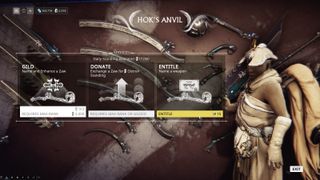
Warframe.Market is the best place to organize trades with other players and list items that you would like to sell for Platinum. Getting involved with trading in Warframe is something that could use a whole other guide, but if you're willing to spend a bit of cash to buy Platinum, you can use Warframe.Market to buy rare mods instead of trying to farm them—a really useful way to save on time. Youtuber 'xplainthegame' has a great guide for using Warframe.Market.
DapperMuffin's Warframe Handbook is the most comprehensive guide to Warframe out there that handily breaks down every major system and concept in a really easy to read way. I also enjoy using this Ultimate Beginner's Guide to Warframe 2018 because it has some great recommendations of weapons and warframes new players should focus on.
Now that you have a grasp on the basics and a bookmark bar stuffed full of resources, the next steps are up to you. Like I said, there's no real endgame in Warframe and it's up to the player to decide what is worth their time. One area worth checking out is the Plains of Eidolon, a vast open world zone full of dangerous, towering Eidolons. Though it unlocks early on, the Plains are best visited after you've completed a good chunk of Star Chart.
Another major milestone to look forward to is completing the few structured quests that can be found in your codex. Of those, the most important one is The Second Dream, which begins a series of "cinematic quests" that help fill in a great deal of information about Warframe's story. They're cool as hell.
The best thing you can do, though, is get involved with the community, make friends, and try out a little of everything. Warframe is an inherently social game—more so than most MMOs—and it also has an enormous amount of things to do. You'll never accomplish everything in one weekend and I routinely meet players that have invested thousands of hours playing. That won't appeal to everyone, but if you can learn how to appreciate and understand Warframe, you'll also learn how easy it is to let an entire evening slip away looting and shooting.
With over 7 years of experience with in-depth feature reporting, Steven's mission is to chronicle the fascinating ways that games intersect our lives. Whether it's colossal in-game wars in an MMO, or long-haul truckers who turn to games to protect them from the loneliness of the open road, Steven tries to unearth PC gaming's greatest untold stories. His love of PC gaming started extremely early. Without money to spend, he spent an entire day watching the progress bar on a 25mb download of the Heroes of Might and Magic 2 demo that he then played for at least a hundred hours. It was a good demo.